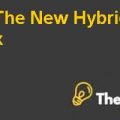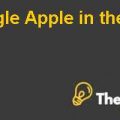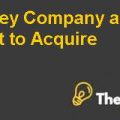Netscape’s Ipo Case Solution
Other Financing sources
The other possible financing for the firms operating in the technology industry is to go for private equity offering; whereby the companies like Netscape have to make private negotiations with few financial or non-financial institutions, which provides the desired funds to the companies with ownership in the capital structure of those companies, in the form of private shares or other securities, which are convertible into common stock. But the market for private equity transactions is very illiquid and the private investors have to find the buyer and then they have to sell their stake with proper negotiations.
Moreover, the company could meet its capital funds’ requirement through debt financing, whereby it can issue bonds at simple or floating rate, depending on the market conditions. The debt financing will impose risk-son the credit rating of Netscape, which-will increase the company’s financial leverage levels and debt to equity ratio. Additionally, the company has a negative times interest earned ratio, which means that it does not have much ability to cover its interest expenses from its operating income. The lenders will require Netscape to put up its assets or other securities as pledge against the funding or the lender may charge high interest rates, due to increased risk levels.
Initial Public Offering
Initial Public offering refers to the first time issuance of company’s shares in the general public. The key objective in issuing the IPO is to raise the funds and to maintain the liquidity position of the company. The IPO has both its advantages as well as disadvantages, which are explained below:
Advantages of Going Public
- The initial public offering raises the funds required for the future capital investments. The company can use these funds to support its growth expansion, to finance the research and development costs, to acquire new technology and to hi-renew employees for expanded operations, etc. Conclusively, IPOs generate massive amount of money, which can transform a company’s growth trajectory.
- The IPO is a potential source of marketing for the company as it provides the customers and public information about the existence of a company. If a company needs to increase its exposure of products to the customers, then it can bring itself to the spotlight by issuing the IPO. The companies, in return, receive attention and credibility among the general public as well as the potential customers.
- IPOs reduce the overall company’s cost of capital. Before going public, the companies raise funds through private equity transactions or bank loans, which requires higher cost of financing. The loans provided by the financial institutions come up with high interest rates because of the high risks associated with the company. On the other hand, the companies can easily go public with less costs and they can even raise further money by subsequent equity offerings at relatively lower costs.
Disadvantages of Going Public
- The IPOs increase the regulatory requirements for the company after going public. It is because unlike a private company; the public company has to reveal periodic financial statements to the general public in accordance with the standards and rules, i.e. US GAAP or IFRS. These regulations are costly as well as burdensome, because the company would be required to employ special staff for preparing financial reports and an auditing committee for timely disclosure of the financial statements.
- The company’s stock price is much vulnerable to the market pressures as the leaders or the company’s management believe in its long term success, but if the investors hold a negative sentiment about the company’s performance regarding the upcoming future, then the market sentiments can result in a significant drop in the market price as well as in the company’s value.
- The IPOs result in a loss of the ownership control, as the power is being distributed to the shareholders of the company. The shareholders require the management to take decisions in best interest, which creates value to the company and to the shareholders. If the shareholders are not convinced with the decisions taken by the leaders, then they can force the company to appoint new leadership by using the voting power.
- The IPOs involve huge transaction costs along with the recurring costs of the regulatory compliance's. Among these costs; the largest one is the fee charged by the underwriters, i.e. round 5% to 7% of the total issued amount.
Discounted Cash Flows Valuation
The company initially planned to issue to $3.5 million shares at an offer price of $14, however, afterwards it revised its offer price from $14 to $28, as it aimed to increase the offering from 3.5 million shares to 5 million. In order to evaluate the offer price being fair, overvalued or undervalued; a discounted cash flow valuation analysis has been performed by forecasting the free cash flows, for a period of 10 years from 1996 – 2005.
Appendix 2 shows the assumptions taken in forecasting the income statement and free cash flows of the company for a period of 10 years, i.e. from 1996 to 2005. First of all, the revenue growth rate is foretasted based on the three revenue categories and their growth since last year. The revenue from Netscape Navigator for the first and second quarters of 1995 are: 49% and 65%, 36% and 28% from server and integrated applications and 5% and 7% from the service revenues respectively, resulting in the total revenue growth rate of 50.4%. (See Appendix 2)
The cost of goods sold is calculated as a percentage of sales for each year. In 1995, the COGS is 10.44% of sales, which is assumed to remain constant for next ten years. The Research and development expense of 36.78% (in terms of sales) is assumed to remain same for a period of 1996-2005.
The other operating expenses, including: sales and marketing, general and administrative and property rights agreement and related charges are 80.9% of the sales revenue in 1995, which are assumed to decrease on a straight line basis for a period of six years and remaining constant at 20.9% of the sales revenue for the next years, till 2005.
The tax rate in forecasting the income statement and free cash flow is kept as 34% and the depreciation is kept as 5.5% of the sales revenue, based on the 1995 year’s depreciation. The terminal growth rate after 2005 is assumed to be 4% and the weighted average cost of capital is assumed to be 12%.
Appendix 3 (in excel) shows the foretasted income statement of Netscape for a period of 10 years, i.e. from 1996 to 2005, which has resulted in the net loss for the years 1996 and 1997 and net profits from 1998 to 2005. Afterwards, the depreciation expense is added and the capital expenditures are deducted from the net earnings of the company to calculate the company’s free cash flows..........................
This is just a sample partial case solution. Please place the order on the website to order your own originally done case solution.













